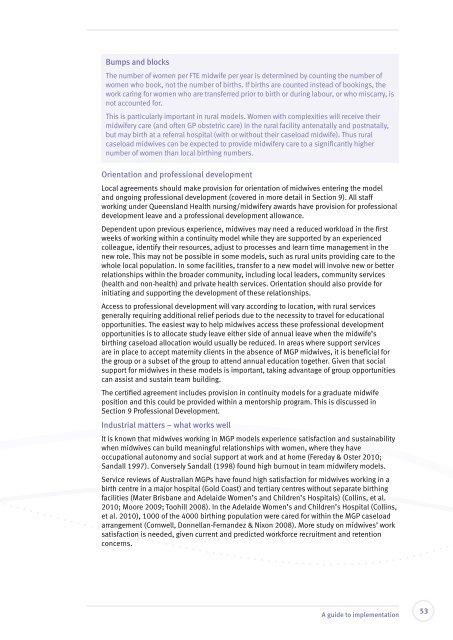Delivering continuity of midwifery care to Queensland women
Delivering continuity of midwifery care to Queensland women
Delivering continuity of midwifery care to Queensland women
Create successful ePaper yourself
Turn your PDF publications into a flip-book with our unique Google optimized e-Paper software.
Bumps and blocks<br />
The number <strong>of</strong> <strong>women</strong> per FTE midwife per year is determined by counting the number <strong>of</strong><br />
<strong>women</strong> who book, not the number <strong>of</strong> births. If births are counted instead <strong>of</strong> bookings, the<br />
work caring for <strong>women</strong> who are transferred prior <strong>to</strong> birth or during labour, or who miscarry, is<br />
not accounted for.<br />
This is particularly important in rural models. Women with complexities will receive their<br />
<strong>midwifery</strong> <strong>care</strong> (and <strong>of</strong>ten GP obstetric <strong>care</strong>) in the rural facility antenatally and postnatally,<br />
but may birth at a referral hospital (with or without their caseload midwife). Thus rural<br />
caseload midwives can be expected <strong>to</strong> provide <strong>midwifery</strong> <strong>care</strong> <strong>to</strong> a significantly higher<br />
number <strong>of</strong> <strong>women</strong> than local birthing numbers.<br />
Orientation and pr<strong>of</strong>essional development<br />
Local agreements should make provision for orientation <strong>of</strong> midwives entering the model<br />
and ongoing pr<strong>of</strong>essional development (covered in more detail in Section 9). All staff<br />
working under <strong>Queensland</strong> Health nursing/<strong>midwifery</strong> awards have provision for pr<strong>of</strong>essional<br />
development leave and a pr<strong>of</strong>essional development allowance.<br />
Dependent upon previous experience, midwives may need a reduced workload in the first<br />
weeks <strong>of</strong> working within a <strong>continuity</strong> model while they are supported by an experienced<br />
colleague, identify their resources, adjust <strong>to</strong> processes and learn time management in the<br />
new role. This may not be possible in some models, such as rural units providing <strong>care</strong> <strong>to</strong> the<br />
whole local population. In some facilities, transfer <strong>to</strong> a new model will involve new or better<br />
relationships within the broader community, including local leaders, community services<br />
(health and non-health) and private health services. Orientation should also provide for<br />
initiating and supporting the development <strong>of</strong> these relationships.<br />
Access <strong>to</strong> pr<strong>of</strong>essional development will vary according <strong>to</strong> location, with rural services<br />
generally requiring additional relief periods due <strong>to</strong> the necessity <strong>to</strong> travel for educational<br />
opportunities. The easiest way <strong>to</strong> help midwives access these pr<strong>of</strong>essional development<br />
opportunities is <strong>to</strong> allocate study leave either side <strong>of</strong> annual leave when the midwife’s<br />
birthing caseload allocation would usually be reduced. In areas where support services<br />
are in place <strong>to</strong> accept maternity clients in the absence <strong>of</strong> MGP midwives, it is beneficial for<br />
the group or a subset <strong>of</strong> the group <strong>to</strong> attend annual education <strong>to</strong>gether. Given that social<br />
support for midwives in these models is important, taking advantage <strong>of</strong> group opportunities<br />
can assist and sustain team building.<br />
The certified agreement includes provision in <strong>continuity</strong> models for a graduate midwife<br />
position and this could be provided within a men<strong>to</strong>rship program. This is discussed in<br />
Section 9 Pr<strong>of</strong>essional Development.<br />
Industrial matters – what works well<br />
It is known that midwives working in MGP models experience satisfaction and sustainability<br />
when midwives can build meaningful relationships with <strong>women</strong>, where they have<br />
occupational au<strong>to</strong>nomy and social support at work and at home (Fereday & Oster 2010;<br />
Sandall 1997). Conversely Sandall (1998) found high burnout in team <strong>midwifery</strong> models.<br />
Service reviews <strong>of</strong> Australian MGPs have found high satisfaction for midwives working in a<br />
birth centre in a major hospital (Gold Coast) and tertiary centres without separate birthing<br />
facilities (Mater Brisbane and Adelaide Women’s and Children’s Hospitals) (Collins, et al.<br />
2010; Moore 2009; Toohill 2008). In the Adelaide Women’s and Children’s Hospital (Collins,<br />
et al. 2010), 1000 <strong>of</strong> the 4000 birthing population were <strong>care</strong>d for within the MGP caseload<br />
arrangement (Cornwell, Donnellan-Fernandez & Nixon 2008). More study on midwives’ work<br />
satisfaction is needed, given current and predicted workforce recruitment and retention<br />
concerns.<br />
A guide <strong>to</strong> implementation<br />
53
















